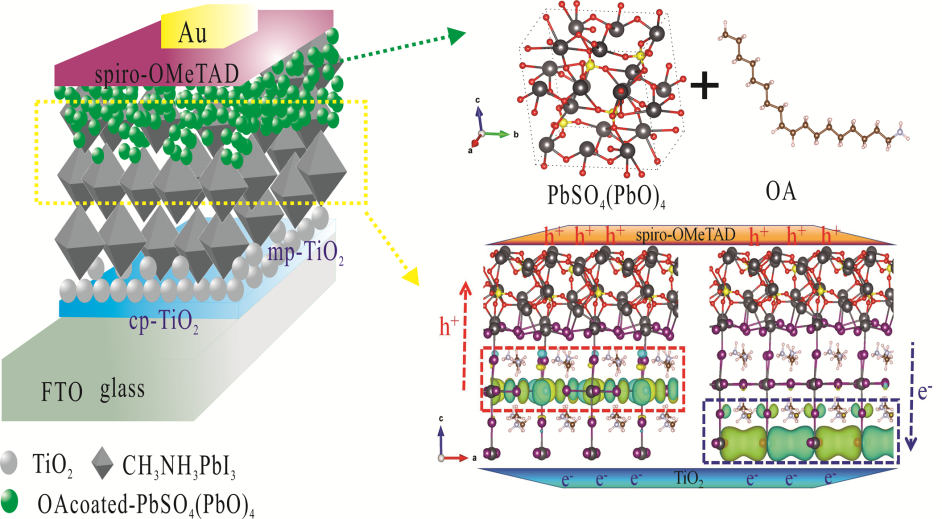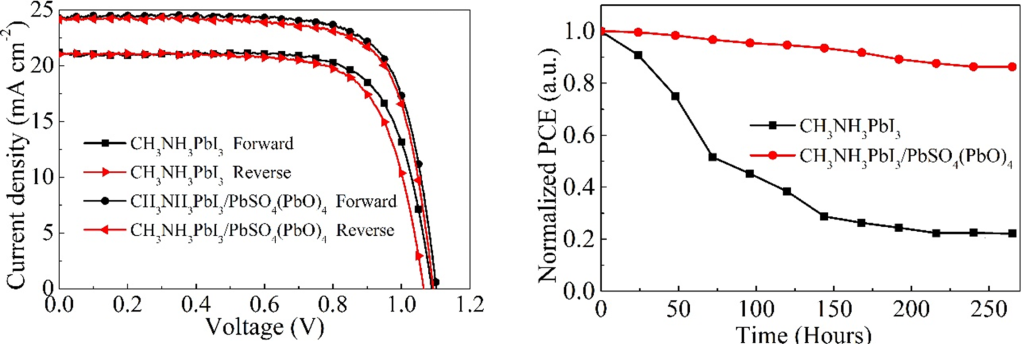Recently, the research group of Chong Chen, a distinguished professor of Henan Key Laboratory of Photovoltaic Materials of Henan University, has made important progress in the research field of perovskite solar cells (PSCs). The paper with a title of “Efficient and stable perovskite solar cells thanks to dual functions of oleyl amine-coated PbSO4(PbO)4 quantum dots: defect passivation and moisture/oxygen blocking”, has been published in the top international energy journal "Nano Energy" (impact factor, 16.602).

Schematic of PSCs and the electron/hole wave function distributions for the CH3NH3PbI3/PbSO4(PbO)4 interface.

The J-V characteristics and normalized PCE retentions of PSCs with and without PbSO4(PbO)4.
The defects in perovskite crystals and the penetration of moisture/oxygen into the perovskite layer are major problems for perovskite solar cells (PSCs) to achieve long-term stability and high power conversion efficiency (PCE). However, there is still a lack of multifunctional passivation materials to solve these problems. For the first time, Chong Chen's group reported oleyl amine-coated PbSO4(PbO)4 quantum-dots (QDs), as a passivation material with dual functions to simultaneously passivate the surface defects and block the penetration of moisture/oxygen into the perovskite layer for stable and efficient PSCs. The PbSO4(PbO)4 QDs significantly reduce the defect density of the as-prepared CH3NH3PbI3 films by passivating under-coordinated Pb ions and I anions and effectively enhance charge extraction efficiency at the TiO2/CH3NH3PbI3 and CH3NH3PbI3/spiro-OMeTAD interfaces. Moreover, the hydrogen bond between H atoms of the OA and I atoms of the perovskite and the interface electric field at CH3NH3PbI3/OA interface also contribute to the improvement of efficiency and stability of PSCs. Finally, higher PCE (20.02%) is achieved by the PSCs with OA-coated PbSO4(PbO)4 QDs compared to that (16.86%) of the PSCs without OA-coated PbSO4(PbO)4, corresponding to a 18.7% enhancement. Moreover, the PSCs with OA-coated PbSO4(PbO)4 QDs maintain 90% of initial efficiency after operation for 280 h, indicating better stability than the PSCs without PbSO4(PbO)4 QDs. The research provides a new way to simultaneously improve the performance and stability of perovskite solar cells by using a passivation material with dual functions.
The first organization to complete the paper is Henan University. Chong Chen and Fumin Li are the co-first authors, Prof. Chong Chen is the first corresponding author, and Prof. Qingsong Huang of Sichuan University and Prof. Mingtai Wang of Hefei Institutes of Physical Science, Chinese Academy of Sciences (CAS) are the co-corresponding authors. This study was funded by National Science Foundation for Young Scientists of China (Grant Nos. 61704048, F030406), National Natural Science Foundation of China-Talent Training Fund of Henan (Grant No. U1404616), Program for Science &Technology Innovation Talents in Universities of Henan Province (19HASTIT049), Seed Fund of Young Scientific Research Talents of Henan University (Grant No. CX0000A40540) and Natural Science Foundation of Henan Province (Grant No. 162300410021).
Prof. Chong Chen's group has been committed to the research of perovskite solar cells, quantum-dot solar cells and polymer solar cells. They have published more than 40 papers in internationally renowned SCI journals such as Adv. Funct. Mater., Nano Energy, Nat. Commun., J. Mater. Chem. A, ACS Appl. Mater. Inter., J. Power Sources, J. Mater. Chem. C, authorized 8 invention patents, and directed more than 10 projects in solar cell fields. Meanwhile, the group has carried out extensive exchanges and cooperation with well-known research institutions and universities, such as Hefei Institutes of Physical Science, CAS, Ningbo Institutes of Materials Technology and Engineering, CAS, Institute of Chemistry, CAS, Korea Institute of Advanced Science and Technology (KAIST), Sichuan University, Jilin University, University of Pittsburgh, and National Chiao Tung University.
DIO: 10.1016/j.nanoen.2019.104313
Web: https://doi.org/10.1016/j.nanoen.2019.104313
 俄文 /
Исследование /
Content
俄文 /
Исследование /
Content
